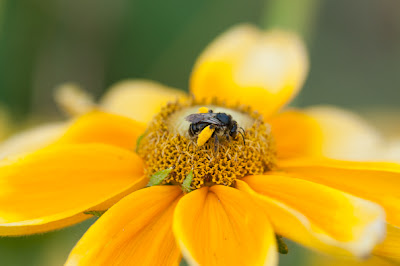 |
| Bumblebee on annual sunflower. Note pollen on her leg. |
 |
| Another bumblebee, possibly a male, dusty with pollen, feeding on anise hyssop flower |
 |
| Megachile (leafcutter) female bee on Mexican sunflower |
 |
| Possible long-horned bee female on rudbeckia, 'Prairie Sun' . Note pollen 'pantaloons.' |
Fall is not the best time to be a bee. Unless you are a honeybee whose colony maintains a low level of activity all winter (It’s true – they do not hibernate but form a cluster around the queen and feed off the stores of honey put away during the summer. The queen actually starts laying eggs in January, in the depths of the winter.) you will die if you haven’t already. Most bees are solitary, making nests either in the ground or in hollowed woody stems of plants such as raspberry canes. There they lay their eggs and provide food for the developing larvae which can overwinter as adults ready to hatch out in the spring. But it is the end for the female egg layers. Males fare no better, lasting only to mate with the females and then to perish with the passing of summer. Male bumblebees, for example, become more numerous only in late summer when they emerge to fertilize the newly hatched queen bumblebees that overwinter by digging down a bit in the ground. They are the only bumblebees to live; the queen of the year along with all her offspring except the new queens do not survive into the winter. They, alas, fall in the fall.
 |
| Unidentified wasp on Clethra |
A note of practical significance here – the same is true of wasps. A hornet nest full of potentially aggressive insects dies over the winter so save the poison spray if the insects are not endangering anyone. The nest is unlikely to be reused, but if you are concerned, after the first frost, you can put a rock or other barrier in the entrance to the nest. Only a mated queen will survive and you are not likely to find her. Remember that wasps are actually beneficial insects in the role they play as predators keeping insect populations under control, and for the role they play in pollination.





nice post!
ReplyDelete